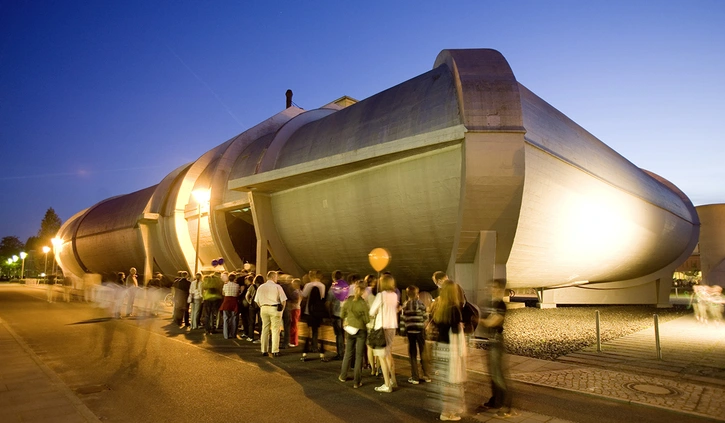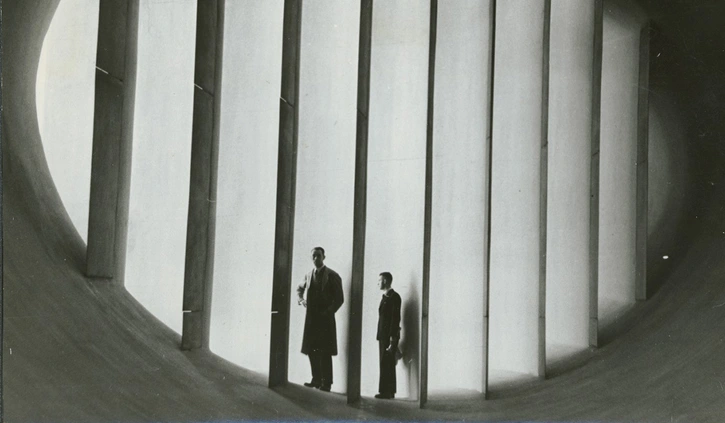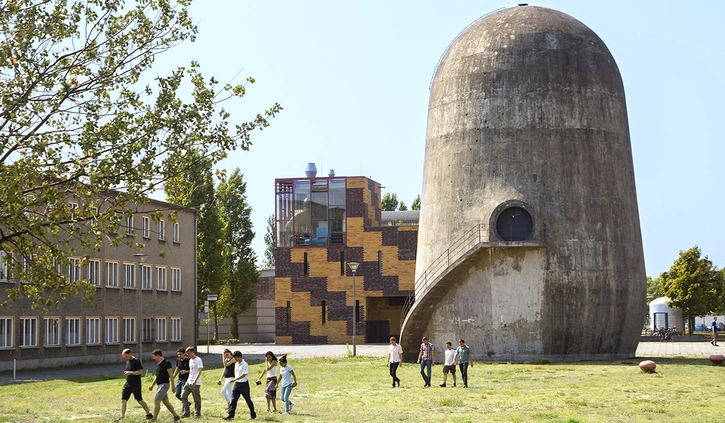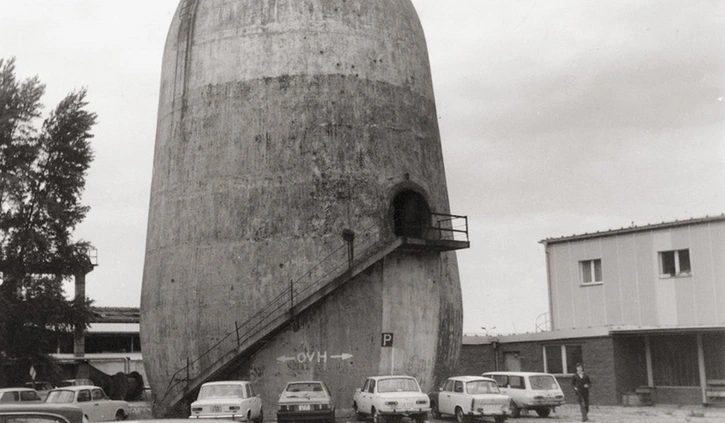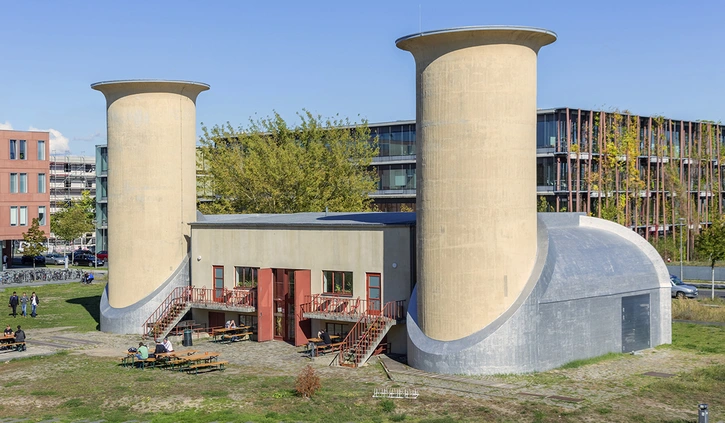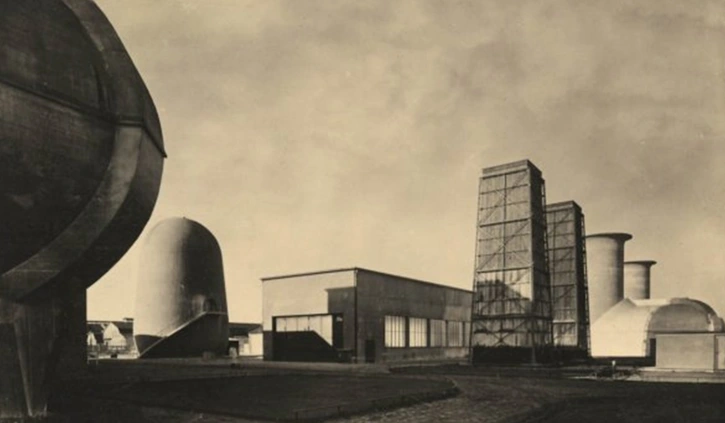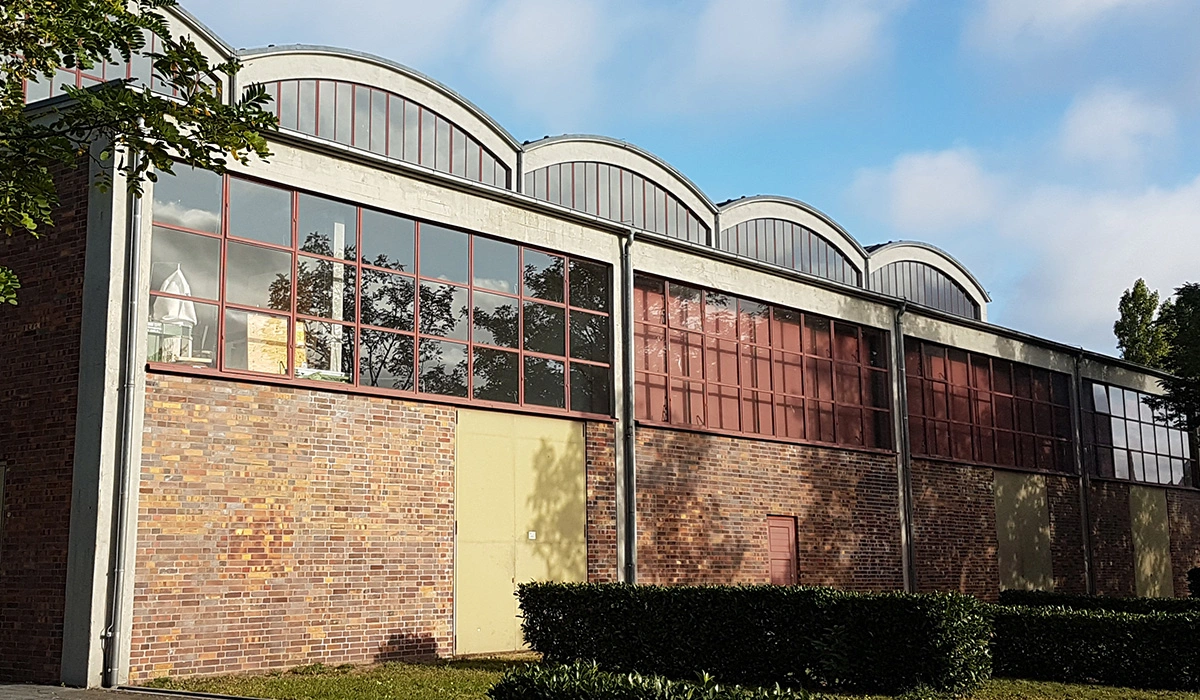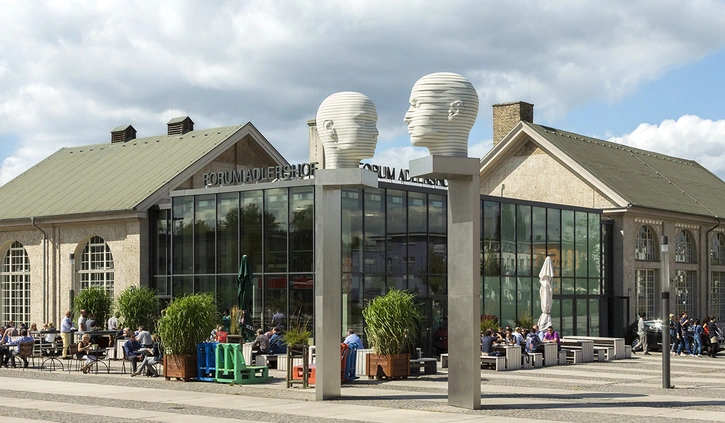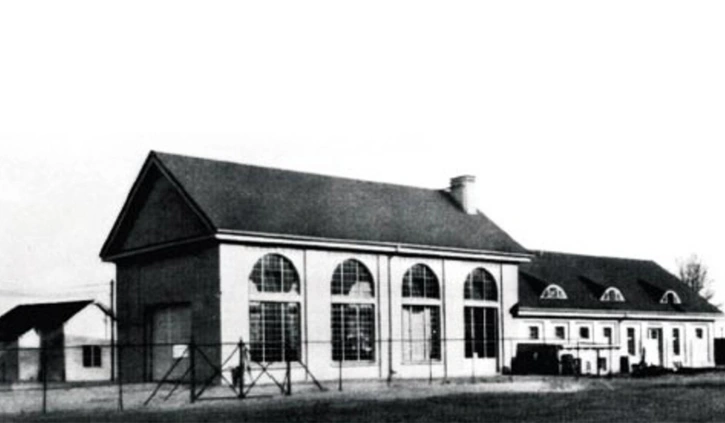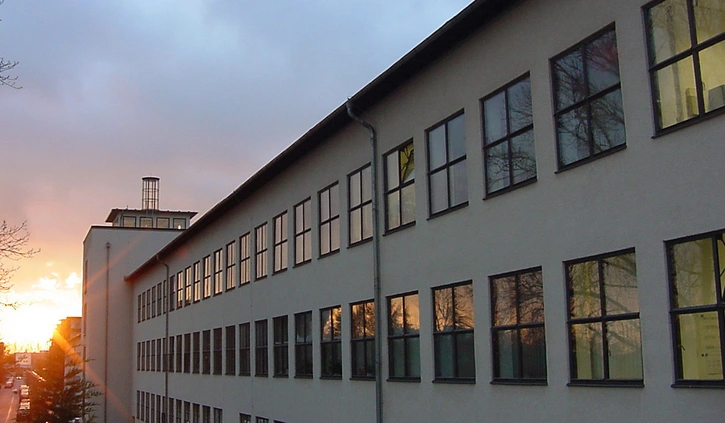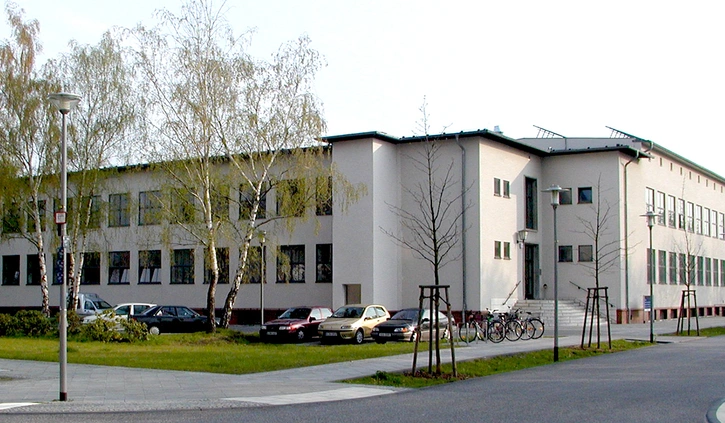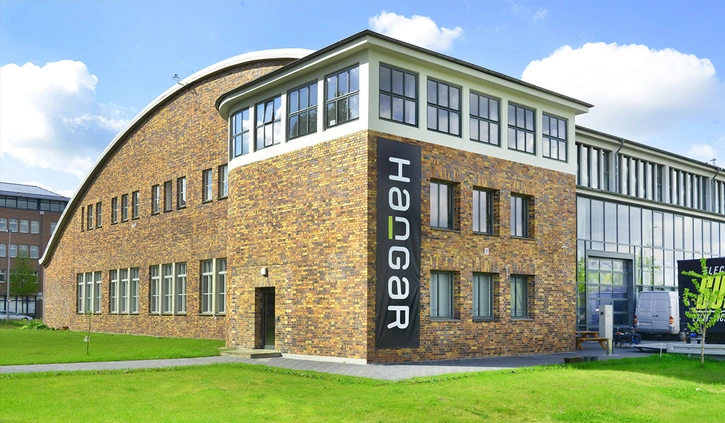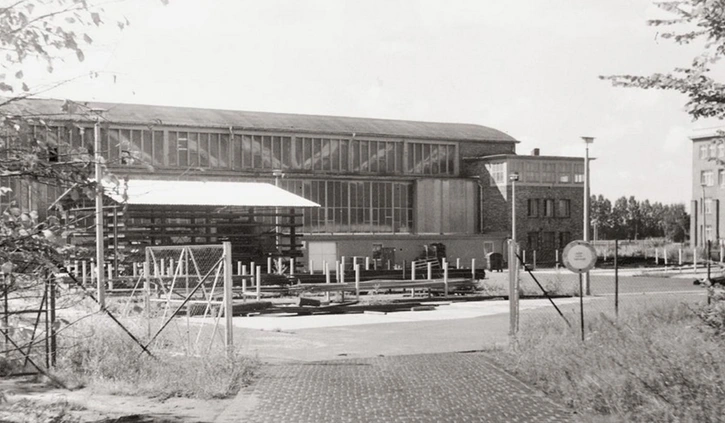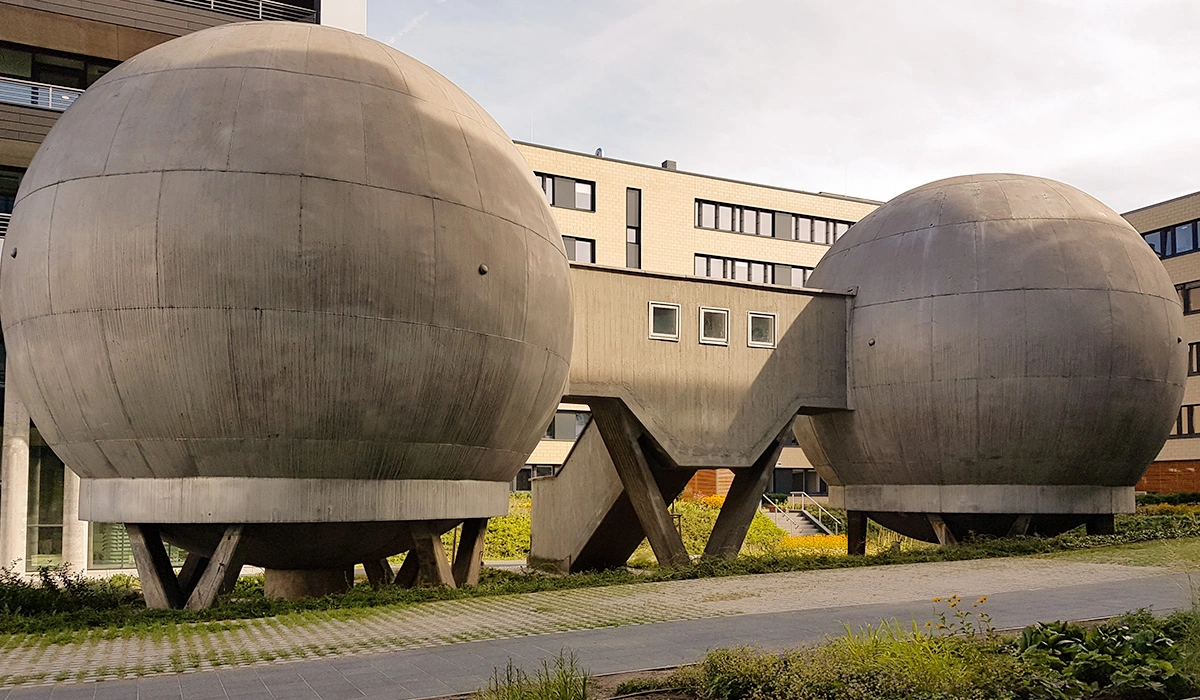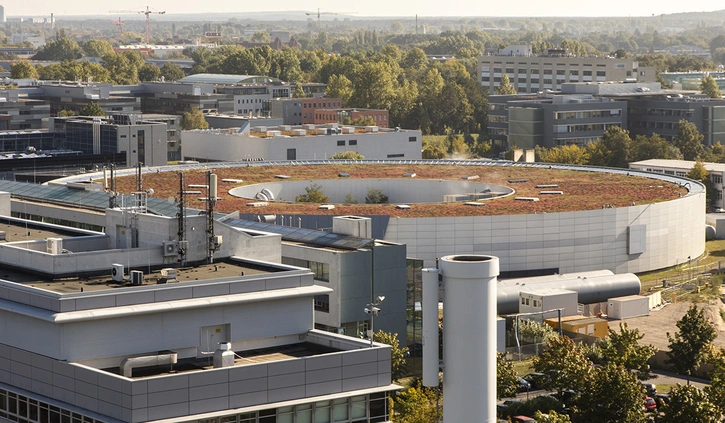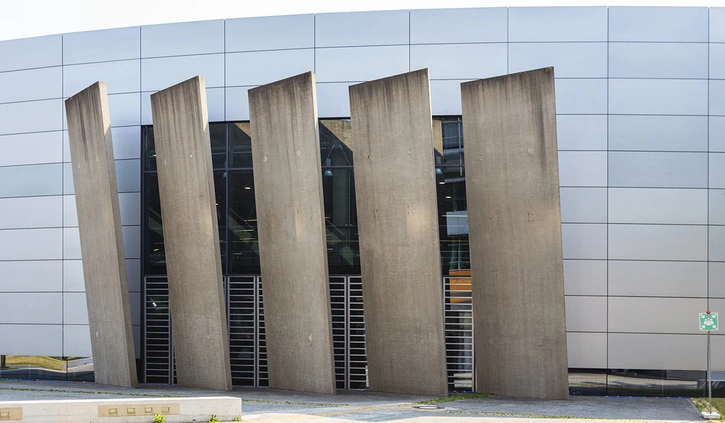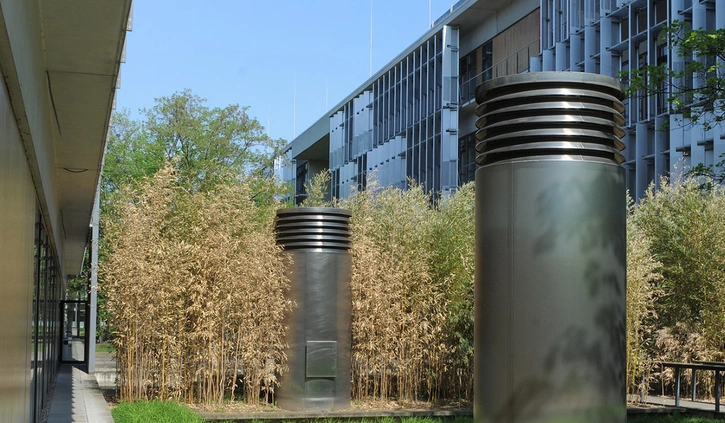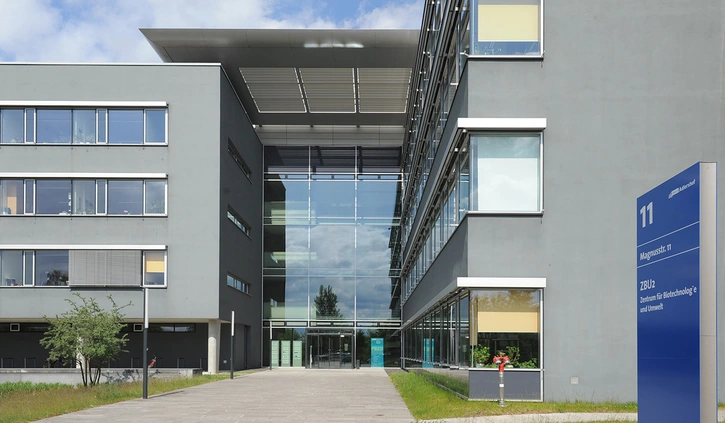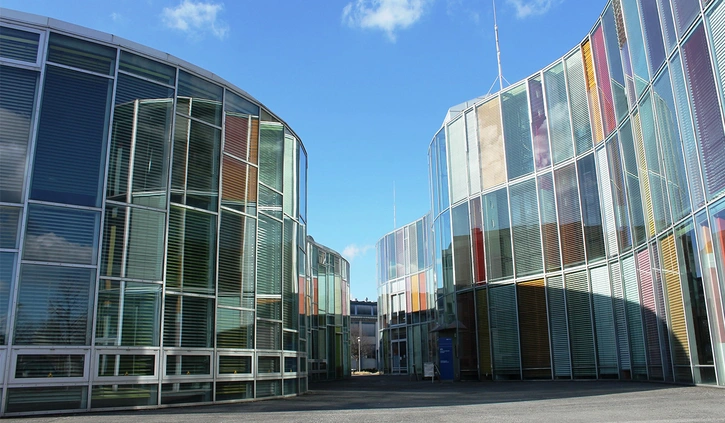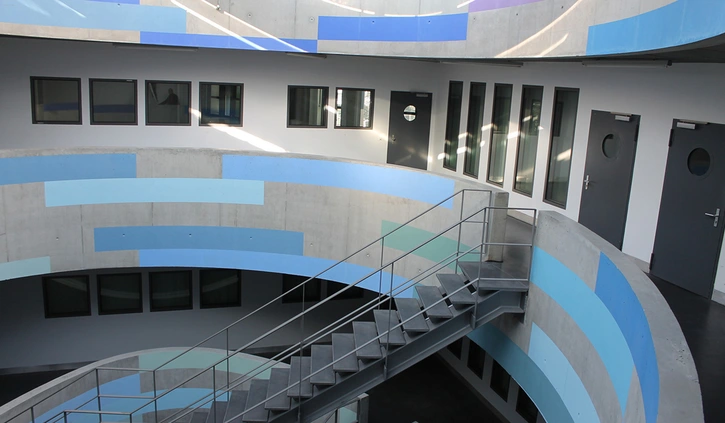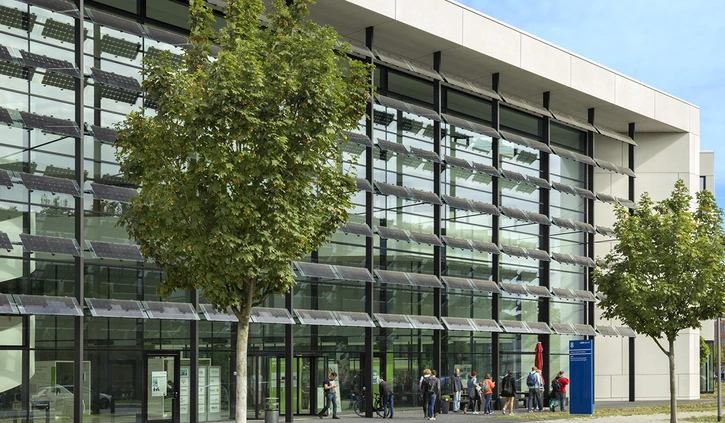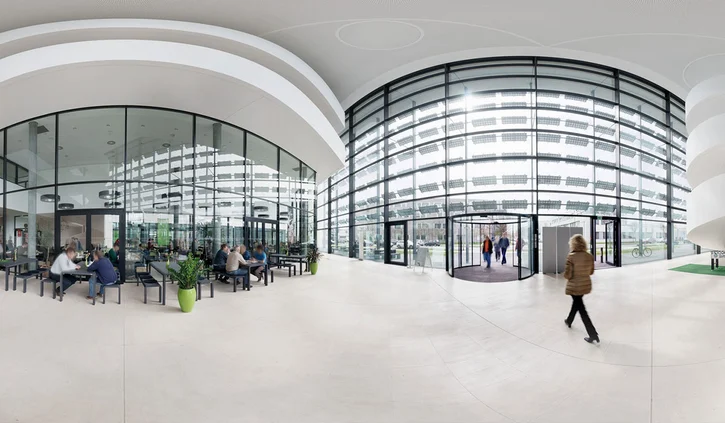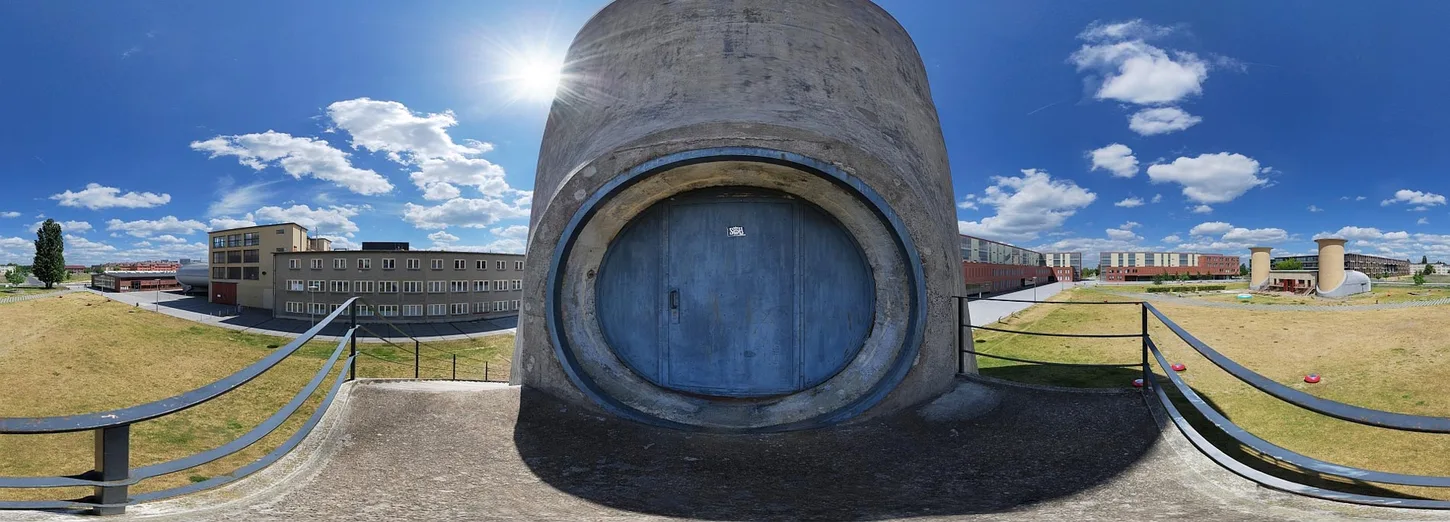Architectural and historical highlights
To activate external content from OpenStreetMap (OSM), we need your consent. By clicking on a button, you consent to the transmission of your data to OSM. Permanent activation applies to all OSM maps on this website.
Great Wind Tunnel (Aerodynamic Park)
Technical monument
Years of construction: 1932 to 1934
Design: Brenner, Hermann & Deutschmann, Werner (Civil Engineer)
Construction: Dyckerhoff und Widmann & Beton- und Monierbau AG
Building owner: Deutsche Versuchsanstalt für Luftfahrt (DVL)
Location: Newtonstraße 18
Three unusually designed buildings in the Aerodynamic Park bear witness to the long tradition of aviation research in Adlershof. They were built in the mid-thirties of the last century by the German Aviation Research Institute (DVL). Originally, the Aerodynamic Park also included a small and a medium wind tunnel, as well as a high-speed tunnel, which were demolished. Today only two objects are still preserved: The Great Wind Tunnel and the ‘Trudelturm’, a tailspin wind tunnel.
The tubular reinforced concrete structure of the Great Wind Tunnel is 120 m long, with a diameter of 12 m. Until the end of the Second World War, it was used to simulate the behaviour of aircraft. The aerodynamic investigations of aircraft parts in air currents served to optimise the shape and surface of the aircraft.
Today, interested visitors can take part in guided tours and events such as the Long Night of the Sciences and take a look inside the monument of aviation history, which is also a popular backdrop for film, television and dance productions.
Tailspin Wind Tunnel “Trudelturm” (Aerodynamic Park)
Technical monument
Years of construction: 1934 to 1936
Design: Brenner, Hermann & Deutschmann, Werner (Civil Engineer)
Construction: Dyckerhoff und Widmann & Beton- und Monierbau AG
Building owner: Deutsche Versuchsanstalt für Luftfahrt (DVL)
Location: Newtonstraße 18
On the lawn between Brook-Tayler-Straße and Newtonstraße, a building relic of the former aviation location Johannisthal/Adlershof still stands today and tells of the beginnings of German aviation research. The listed tailspin wind tunnel, also known as the “Trudelturm”, is one of five wind tunnels built in Adlershof by the German Aviation Research Institute (DVL). Built in reinforced concrete, it is 20 m high, has a maximum diameter of around 12 m and its average wall thickness is 0.30 m. For the 1930s, its construction and operating principle represented a remarkable innovation. A vertical air flow could be generated inside. At that time, this was the only possibility for years to simulate the dangerous flight state of the spin in the laboratory.
Today, this exotic building attracts attention thanks to its exposed location and egg-shaped appearance and is one of the most popular photo motifs on the Adlershof campus.
Sound-insulated engine test bench (Aerodynamic Park)
Technical monument
Years of construction: 1933 to 1936
Design: Brenner, Hermann & Deutschmann, Werner (Civil engineer)
Construction: Dyckerhoff und Widmann & Beton- und Monierbau AG
Building owner: Deutsche Versuchsanstalt für Luftfahrt (DVL)
Location: Newtonstraße 16
The 15 m high towers of the engine test bench protrude from the ground like two biscuit rollers. Aircraft engines were tested in the sound-insulated reinforced concrete structure until the end of World War II. After that, the building was used as a warehouse and workshop for many years. It received the distinction of technical monument at the end of the 1990s.
Today the former test bench is home to the student centre “Motorenprüfstand” (short MoPs). On the Adlershof campus, the self-administered project room is a student meeting place offering coffee and tea, and is also used for events.
Engine altitude test bench (Aerodynamic Park)
Technical monument
Years of construction: 1933 to 1936
Design: Brenner, Hermann & Deutschmann, Werner (Civil engineer)
Construction: Dyckerhoff und Widmann & Beton- und Monierbau AG
Building owner: Deutsche Versuchsanstalt für Luftfahrt (DVL)
Location: Brook-Taylor-Straße 6
Until the end of the Second World War, the reinforced concrete building with clinker facade and its undulating roof and large window fronts in Brook-Taylor-Straße housed the altitude test benches of the DVL (German Research Institute for Aviation). There, aircraft engines were tested for their suitability for altitude. Under altitude conditions (simulated altitude of max. 24 km), combustion air was fed to them. From the 1950s onwards, the building housed various workshops and later the technical centre of the Centre for Scientific Instrument Engineering of the GDR Academy of the Sciences.
Forum Adlershof
Year of construction: 1912
Location: Rudower Chaussee 24
The former laboratory and workshop buildings are the oldest remaining buildings of the nascent aviation research in the German Empire. With their completion and the foundation of the German Aviation Research Institute (DVL) in 1912, aviation research was established at Johannisthal/Adlershof airfield. After World War II, the buildings were used by the “Felix Dzierzynsky” guard regiment as a motor vehicle workshop and warehouse.
The buildings' original appearance was permanently changed by many extensions and conversions. After reunification, thanks to the initiative of the Berlin Monument Authority and the Berlin Senate, the two “Forum buildings” were cleared and the facades reconstructed with the help of old photos and architectural drawings.
WISTA Buildings
Monument
Year of construction: 1935
Design: Hermann Brenner, Werner Deutschmann (Civil engineers)
Construction: Dyckerhoff und Widmann & Beton- und Monierbau AG
Building owner: Deutsche Versuchsanstalt für Luftfahrt (DVL)
Locations: Rudower Chaussee 17-19, Kekuléstraße 2-4
The three-storey main building with tower and the hall building adjoining at right angles (former Thomsen hall, now Bunsen hall), built in 1935, were used by the DVL as office and laboratory buildings. After the end of World War II, Soviet and GDR army units used parts of the building until the Academy of Sciences took over the entire building in the late 1950s. With the research areas of mathematics, physics, materials research, cybernetics and chemistry, the Institute for Optics and Spectroscopy and for Mathematics, the basis was established here for an internationally renowned research centre in the GDR, whose success story was continued after reunification with the founding of the Adlershof Technology Park.
Today, the buildings house the offices of the operating company WISTA Management GmbH, its subsidiaries WISTA.Plan GmbH and WISTA.Service GmbH as well as the offices of the Forschungsverbund Berlin e.V. and the science network IGAFA.
Aircraft hangars
Monument
Locations: Ludwig-Boltzmann-Straße 1 and 3 / Friedrich-Wöhler-Straße 1
Johannisthal/Adlershof is widely known as the cradle of German motor aviation. On 26 September 1909, the first flying machines took to the skies on the recently completed Johannisthal airfield, rattling in the air. Two former aircraft hangars, built in the first half of the last century, still remind us of the time of the nefarious aviators in spectacular air shows. Their daring and the inventiveness of young companies in the construction of flying machines were the driving force behind the burgeoning German aviation. Many of the successful aviation companies of the time settled on the airfield site and, like the Wright brothers, produced their flying machines locally. A true-to-original replica of a Wright flyer on a scale of 1:1 in the hangar on Ludwig-Boltzmann-Straße, today the headquarters of Air Liquide, recalls the pioneering years of aviation on this site.
Spherical laboratories (“Kugellabore”), also known as “Adlershof’s bosom”
Architectural monument
Years of construction: 1959 to 1961
Design: Karsten Peter Thiessen (Institute Director), Horst Welser (Architect)
Building owner: Institute of Physical Chemistry of the Academy of Sciences
Location: corner Rudower Chaussee / Am Studio
A relic from the times of the Academy of Sciences can be admired in the inner courtyard of the EUROPA CENTER (Rudower Chaussee/Am Studio). The large spherical buildings from the 1960s are the first examples of reinforced concrete shell constructions in the GDR. In 1961, when the facility was commissioned, thermoconstant laboratories were a novelty in Germany and a sign of outstanding technical expertise.
Electron storage ring BESSY II
Year of construction: 1998
Design: Brenner & Partner Architekten, Stuttgart
Location: Albert-Einstein-Straße 15
The large-scale research facility BESSY II is one of the most prominent buildings in Berlin Adlershof. The facility, completed in 1998, generates synchrotron radiation with very high luminosity. Around the ring-shaped storage tunnel, the experimental areas and workplaces for the scientists are arranged along beamlines. The storage ring hall with a diameter of about 120 m and the office and laboratory building (about 210 m long) are connected by a glazed, multi-storey hall. The hall is intended as a meeting point; here are cafeteria, meeting rooms and the elevator to the upper floors.
Centre for Biotechnology and Environment I and II (ZBU)
ZBU I
First used: 1997
Design: Eisele, Fritz, Bott Architekten, Darmstadt
Location: Volmerstraße 5-9
At the end of the 1990s, the first Centre for Biotechnology and Environment was established in the Technology Park. On 12,100 square metres, office, laboratory and production space for young companies was created in an environmentally friendly design. Not only flexibility, but also extensive energy saving and the lowest possible environmental impact of the building were the main planning tasks. Four components contribute to this: component cooling via the cavity ceiling, the shading system to prevent the facade from heating up while at the same time optimising the incidence of daylight, the photovoltaic facade of the entrance hall and the rainwater utilisation system.
ZBU II
First used: 2006
Design: Architekt Prof. Gunter Henn
Building owner: WISTA Management GmbH
Location: Magnusstraße 11
In an ensemble of four building wings with generous glass surfaces, lots of steel and exposed concrete, young companies can find 7,200 square metres of office and laboratory space with modern technical equipment. The architects paid great attention to a communicative centre. This is formed by a central access hall with an elevator and an attractive architectural staircase system, which links the four floors with each other, offers employees and visitors an overview of the building and provides balconies for meeting and presentation opportunities. In a modern rainwater utilization system, rainwater is collected in three basins in front of the building, from which it can slowly seep into the ground.
More information about the Centres for Biotechnology and Environment can be found here.
Centre for Photonics and Optics I (ZPO)
First used: 1998
Design: Sauerbruch Hutton Architekten, Berlin
Location: Carl-Scheele-Straße 16
In the design by the architectural office Sauerbruch & Hutton, the two buildings of the ZPO I are conceived on the one hand as strongly identity-forming bodies, and on the other hand their shape is usage-related. Minimal development effort and the need for large, darkenable laboratory areas – laboratories in optical research are operated without daylight – suggested a deep floor plan along a central backbone. With its flowing, undulating bulges, starting from a circular form, the building is reminding of an organic shape and is also known as “amoeba” at the location.
The larger of the two buildings is a multi-storey building with identical and simply structured floors: “usage strips” of 7.20 m width and 7 to 20 m depth, which can be connected to each other, allow rental areas of 100-1,000 square metres, which can be used as offices, laboratories and workshops. Apart from the staircase areas, the multi-storey building has a double glass façade. It offers increased thermal insulation with maximum transparency and allows controlled, natural ventilation of the rooms behind it. The smaller building with the 7.50 m high hall for large-scale experiments is a simple steel construction with glass walls.
Both buildings are enveloped in a changing spectrum of colours: When the sky is overcast, it is the columns that give the building its colouring; when the sun shines, the colour image is intensified by the lowered, differently coloured blinds.
Centre for Photovoltaics and Renewable Energies (ZPV)
Years of construction: 2011 to 2013
Design: Henn Architekten
Location: Johann-Hittorf-Straße / Barbara-McClintock-Straße
The Centre for Photovoltaics and Renewable Energies (ZPV) in Johann-Hittorf-Straße 8 with 8,000 m² of production, laboratory and office space was built especially for companies in the renewable energy sector. The laboratory building was certified in gold by the DGNB in 2015. The following sustainability aspects, which were taken into account during construction and operation, played a role in the certification:
- Recyclable and rottable building materials
- Sound insulation for building envelope and room acoustics
- Extensive roof greening to improve the microclimate
- Rainwater utilisation for restrooms and outdoor facilities
- Highly efficient energy system: heat recovery, concrete core activation, free coolers, heat-insulating outer facade
- Photovoltaic system on the foyer façade as sun protection and for power generation
- Barrier-free public areas, disabled toilet, disabled parking
- Covered charging stations for scooters/pedelecs and e-cars and bicycle parking
More information about the Centre for Photovoltaics and Renewable Energies
